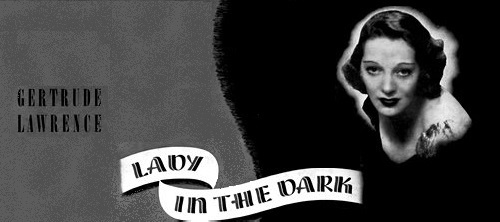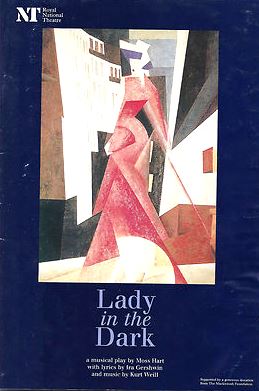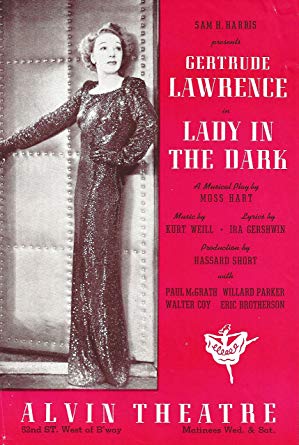
Lady in the Dark a été l’événement musical de la saison 1940-1941, et toutes ses représentations étaient sold-out, y compris les places debout. Tout le monde le savait, cette œuvre était le musical le plus moderne dans laquelle une légende théâtrale jouait le rôle de sa vie. Gertrude Lawrence a joué ce qui était (avec Rose dans le futur Gypsy ()) peut-être le Hamlet des rôles musicaux féminins. Son contrat prévoyait qu'elle avait droit à des vacances l’été. Ainsi, la comédie musicale a joué 162 représentations sold-out, s'est arrêtés les onze semaines de vacances de Gertrude Lawrence, puis a rouvert ses portes à l’automne pour 305 représentations supplémentaires (le total des représentations totalisera 467). Après un US-Tour, en 1943, Lawrence revient au Broadway Theatre pour un 'return engagement' de 83 représentations.

Version 2
Lady in the dark (1997-03-National Theatre Lyttelton Theatre-London)
Type de série: RevivalThéâtre: National Theatre (Londres - Angleterre) Salle : Lyttelton TheatreDurée : 4 mois 3 semaines Nombre : 63 représentationsPremière Preview : mardi 11 mars 1997Première : mardi 11 mars 1997Dernière : samedi 02 août 1997Mise en scène : Francesca Zambello • Chorégraphie : Queeny Sachs • Producteur : Avec : Maria Friedman (Liza Elliott), Paul Shelley (Kendall Nesbitt), Adrian Dunbar (Charley Johnson), Steven Edward Moore (Randy Curtis), James Dreyfus (Russell Paxton), Hugh Ross (Dr. Brooks), Ashleigh Sendin (Miss Foster), Summer Rognlie (Alison Dubois), Charlotte CornwallCommentaires : This was the first collaboration of Ira Gershwin following the death of his brother, and ran for 467 performances in New York in 1941. The leading role was played by Gertrude Lawrence, and the show made a star of newcomer Danny Kaye in the role of a camp photographer with a show-stopping patter number “Tchaikowsky”.
The musical is so constructed that all the numbers are sung during the dream sequences that Liza describes to her doctor. The only exception is the song “My Ship” which serves a special part of the plot: it is a half-remembered song from Liza’s childhood and because Charley is the only man who can complete the song for her, he wins Liza’s love.
55 years after its Broadway debut, this was its first London production, though it did have a production at Nottingham in 1981 with Celeste Holm. The critics found it fascinating and important, but felt it suffered by comparison with “Guys & Dolls” which was currently the opposition under the same National Theatre roofPresse : "...Surprisingly, Maria Friedman turns out to be far better at playing Liza, the cool and often collected editress of Allure Magazine – with her talent for cut and thrust - than as the suffering girl on the verge of a nervous breakdown... Miss Friedman in in sweet voice and artfully holds the balance between drama and music, which Lady in the Dark so cleverly celebrates. It is a rousing occasion." Nicholas de Jongh, The London Evening Standard (12 March 1997)
"...[The Lady in the Dark's] saving grace is Weill's score, which allies the emotional plangency of Berlin period to Broadway idioms...The other good reason for seeing the show, as with Sondheim's Passion, is Maria Friedman's stellar performance. She actually persuades you that inside the professionally masterful but emotionally dithering Liza lurks a badly bruised spirit. She sings the big numbers with a direct lyric simplicity and she allows her Guiletta Massina-like clown instinct to emerge in a circus sequence where she cavorts with the pawkiness of a wild-eyed child. The evening belongs unequivocally to her..." Michael Billington, The Guardian (12 March 1997)
"...By all accounts Gertrude Lawrence was magic as the fashion-mag editor...Maria Friedman, who is fronting what the National claims is the musical's belated British premiere, is not quite so charismatic, but once again she proves herself splendidly versatile, resourceful performer... The supporting cast is fine and Friedman more than fine. When she exits from a big-top fantasy episode to launch first into Weill's celebration of vamps, The Saga of Jenny, and then into his splendedly robust love song. My Ship - well, she had the first-night audience wishing the palm of her hand was larger, so we could spend more time in it." Benedict Nightingale, The Times (12 March 1997)
"...The woman having the crack-up is Liza Elliot, the hotshot editor of a leading fashion magazine. In this role, Maria Friedman is badly miscast. She's too sweet, concessive-looking and breathy to project the drive, authority and magnetism that have got this business-suited woman to the top. It's true that in Sondheim's Passion, Friedman conveyed power, but it was the potency of an implacably loving masochism. Here you need a stronger sense of the enamelled armour Liza has built around herself. For if the charcter in Passion was straightforwardly ugly, in Lady in the Dark, the heroine is found to be compensating for the fact that she was thought unattractive to her parents as a child. It's a discovery that allows the show to employ psychoanalysis to endorse traditional roles. Liza's success has nothing to do with trying to compete on equal terms with men, we deduce from the shrink, rather it's the refusal to risk being hurt by competeting with other women. So of the three complete ciphers who want to marry her, she ends up choosing the one who also wants her job..." Paul Taylor, The Independent (13 March 1997)
"...Despite an excellent cast, Lady in the Dark seems like an exercise in theatrical archaeology... The show isn't helped by the fact that Freudian psychoanalysis, for which Lady in the Dark often seems one long advertisement, is increasingly discredited... What scuppers Lady in the Dark, though, is the ;ack of warmth and audience involvement. Maria Friedman is one of our finest musical-theatre talents, but, although she communicated moments of mental distress as Liza, she never comes close to moving you..." Charles Spencer, The Daily Telegraph (13 March 1997)
Liza Elliott (Gertrude Lawrence), est une éditrice de magazine de mode à succès. Cette dernière se retrouve constamment en proie à l'indécision dans sa vie professionnelle et personnelle. Elle est courtisée par deux hommes, l'éditeur déjà marié Kendall Nesbitt qui tente de divorcer de sa femme pour Liza, et son directeur de la publicité Randy Curtis, et ne peut pas décider qui choisir. Lorsqu'elle décide de recourir à la psychanalyse, elle plonge dans ses rêves et ses souvenirs d'enfance malheureuse. Le musical est constitué ainsi principalement de trois de ses rêves, racontées au psychanalyste. Liza se rend compte qu’elle aime son assistant qui fait preuve de sagesse lorsqu’il termine sa mélodie de rêve, My Ship.
Le thème de la psychanalyse dans le musical serait basé sur les propres expériences de Moss Hart avec le psychanalyste Gregory Zilboorg. Sauf pour la chanson finale, toute la musique de la pièce est entendue dans trois séquences de rêve: le rêve glamour, le rêve de mariage, et le rêve de cirque qui, dans une certaine mesure, deviennent trois petits musicals intégrés dans une pièce de théâtre. La chanson finale, My Ship, fonctionne comme un leitmotiv pour l’insécurité de Liza: au début de chaque rêve, un extrait de cette chanson est entendu, comme c’est une mélodie hantée que Liza reconnaît mais ne peut pas nommer, ou chanter avec des mots, jusqu’à ce que son anxiété soit résolue.
1 Lady in the dark peut-être considéré comme un Top musical
Création
Le musical a ouvert à Broadway à l'Alvin Theatre (l'actuel Neil Simon Theatre) le 23 janvier 1941 et a fermé le 30 mai 1942 après 467 représentations. Le spectacle produit par Sam H. Harris a été mis en scène par Moss Hart avec une direction musicale de Hassard Short et des chorégraphies d’Albertina Rasch. Les acteurs de la création étaient Gertrude Lawrence, Danny Kaye, Bert Lytell, Victor Mature, Margaret Dale, Davis Cunningham et Macdonald Carey.
La performance de Danny Kaye dans le rôle du photographe de mode Russell Paxton, et en particulier sa performance dans la chanson Tschaikowsky (and Other Russians) dans laquelle il énonce les noms de 50 compositeurs russes en 39 secondes, fait de lui une star.
Le musical a fait un US-Tour de huit villes et 160 représentations, et a également joué sur la côte ouest, y compris Los Angeles et San Francisco, pour 56 représentations. Le spectacle est ensuite revenu a Broadway, pour ce que l'on appelle un "return engagement" au Broadway Theatre du 27 février au 15 mai 1943 pour 83 représentations. Gertrude Lawrence a joué son rôle de Liza Elliott dans toutes les salles.
Autres productions
Lady in the Dark a été créée au Royaume-Uni seulement le 9 décembre 1981 au Nottingham Playhouse de Nottingham.
A New York City Center Encores! a proposé un concert semi-scénique du en mai 1994 avec Christine Ebersole.
Et enfin, le musical a été créé à Londres au Royal National Theatre le 11 mars 1997, présentant 63 représentations jusqu’au 2 août 1997, dans une mise en scène de Francesca Zambello et avec Maria Friedman dans le rôle de Liza. La production a reçu le Evening Standard Award du meilleur musical.
Acte I
Glamour Dream
• "Oh Fabulous One in Your Ivory Tower" – Liza Elliott's Serenaders
• "The World's Inamorata" – Liza Elliott and Miss Foster
• "One Life to Live" – Liza Elliott and Russell Paxton
• "Girl of the Moment" – Ensemble
Wedding Dream
• "It Looks Like Liza" – Entire Company
• "This is New" – Randy Curtis and Liza Elliott
• "The Princess of Pure Delight" – Liza Elliott and Children
• "This Woman at the Altar" – Entire Company
Acte II
Circus Dream
• "The Greatest Show on Earth" – Randy Curtis and Ensemble
• "The Best Years of His Life" – Charley Johnson and Randy Curtis
• "Tschaikowsky (and Other Russians)" – Russell Paxton and Ensemble
• "The Saga of Jenny" – Liza Elliott, Jury and Ensemble
Final Scene
• "My Ship" – Liza Elliott (not retained in the film version)
Aucun dossier informatif complémentaire concernant Lady in the dark

Version 1
Lady in the dark (1941-01-Alvin Theatre-Broadway)
Type de série: OriginalThéâtre: Neil Simon Theatre (Broadway - Etats-Unis) Durée : 1 an 4 mois 1 semaine Nombre : 467 représentationsPremière Preview : jeudi 23 janvier 1941Première : jeudi 23 janvier 1941Dernière : samedi 30 mai 1942Mise en scène : Moss Hart • Chorégraphie : Producteur : Avec : Donald Randolph (Dr. Brooks), Jeanne Shelby (Miss Bowers), Gertrude Lawrence (Liza Elliott), Evelyn Wyckoff (Miss Foster, Sutton), Ann Lee (Miss Stevens), Margaret Dale (Maggie Grant), Natalie Schafer (Alison Du Bois), Danny Kaye (Russell Paxton, Beekman, Ringmaster), MacDonald Carey (Charley Johnson), Victor Mature (Randy Curtis), Ward Tallmon (Joe), Nelson Barclift (Tom), Bert Lytell (Kendall Nesbitt), Virginia Peine (Helen), Gedda Petry (Ruthie), Beth Nichols (Carol), Margaret Westberg (Marcia), Dan Harden (Ben Butler), Patricia Deering (Barbara), Davis Cunningham (Jack); The Albertina Rasch Group Dancers: Dorothy Bird, Audrey Costello, Patricia Deering, June MacLaren, Beth Nichols, Wana Wenerholm, Margaret Westberg, Jerome Andrews, Nelson Barclift, George Bockman, Andre Charise, Fred Hearn, John Sweet, William Howell; The Singers: Catherine Conrad, Jean Cumming, Carol Deis, Hazel Edwards, Gedda Petry, June Rutherford, Florence Wyman, Eric Brotherson, Davis Cunningham, Max Edwards, Len Frank, Gordon Gifford, Manfred Hecht, William Marel, Larry Siegle, Harold Simmons; The Children: Anne Bracken, Sally Ferguson, Ellie Lawes, Joan Lawes, Jacqueline Macmillan, Lois Volkman, Kenneth Casey, Warren Mills, Robert Mills, Robert Lee, George Ward, William Welch

Version 2
Lady in the dark (1997-03-National Theatre Lyttelton Theatre-London)
Type de série: RevivalThéâtre: National Theatre (Londres - Angleterre) Salle : Lyttelton TheatreDurée : 4 mois 3 semaines Nombre : 63 représentationsPremière Preview : mardi 11 mars 1997Première : mardi 11 mars 1997Dernière : samedi 02 août 1997Mise en scène : Francesca Zambello • Chorégraphie : Queeny Sachs • Producteur : Avec : Maria Friedman (Liza Elliott), Paul Shelley (Kendall Nesbitt), Adrian Dunbar (Charley Johnson), Steven Edward Moore (Randy Curtis), James Dreyfus (Russell Paxton), Hugh Ross (Dr. Brooks), Ashleigh Sendin (Miss Foster), Summer Rognlie (Alison Dubois), Charlotte CornwallCommentaires : This was the first collaboration of Ira Gershwin following the death of his brother, and ran for 467 performances in New York in 1941. The leading role was played by Gertrude Lawrence, and the show made a star of newcomer Danny Kaye in the role of a camp photographer with a show-stopping patter number “Tchaikowsky”.
The musical is so constructed that all the numbers are sung during the dream sequences that Liza describes to her doctor. The only exception is the song “My Ship” which serves a special part of the plot: it is a half-remembered song from Liza’s childhood and because Charley is the only man who can complete the song for her, he wins Liza’s love.
55 years after its Broadway debut, this was its first London production, though it did have a production at Nottingham in 1981 with Celeste Holm. The critics found it fascinating and important, but felt it suffered by comparison with “Guys & Dolls” which was currently the opposition under the same National Theatre roofPresse : "...Surprisingly, Maria Friedman turns out to be far better at playing Liza, the cool and often collected editress of Allure Magazine – with her talent for cut and thrust - than as the suffering girl on the verge of a nervous breakdown... Miss Friedman in in sweet voice and artfully holds the balance between drama and music, which Lady in the Dark so cleverly celebrates. It is a rousing occasion." Nicholas de Jongh, The London Evening Standard (12 March 1997)
"...[The Lady in the Dark's] saving grace is Weill's score, which allies the emotional plangency of Berlin period to Broadway idioms...The other good reason for seeing the show, as with Sondheim's Passion, is Maria Friedman's stellar performance. She actually persuades you that inside the professionally masterful but emotionally dithering Liza lurks a badly bruised spirit. She sings the big numbers with a direct lyric simplicity and she allows her Guiletta Massina-like clown instinct to emerge in a circus sequence where she cavorts with the pawkiness of a wild-eyed child. The evening belongs unequivocally to her..." Michael Billington, The Guardian (12 March 1997)
"...By all accounts Gertrude Lawrence was magic as the fashion-mag editor...Maria Friedman, who is fronting what the National claims is the musical's belated British premiere, is not quite so charismatic, but once again she proves herself splendidly versatile, resourceful performer... The supporting cast is fine and Friedman more than fine. When she exits from a big-top fantasy episode to launch first into Weill's celebration of vamps, The Saga of Jenny, and then into his splendedly robust love song. My Ship - well, she had the first-night audience wishing the palm of her hand was larger, so we could spend more time in it." Benedict Nightingale, The Times (12 March 1997)
"...The woman having the crack-up is Liza Elliot, the hotshot editor of a leading fashion magazine. In this role, Maria Friedman is badly miscast. She's too sweet, concessive-looking and breathy to project the drive, authority and magnetism that have got this business-suited woman to the top. It's true that in Sondheim's Passion, Friedman conveyed power, but it was the potency of an implacably loving masochism. Here you need a stronger sense of the enamelled armour Liza has built around herself. For if the charcter in Passion was straightforwardly ugly, in Lady in the Dark, the heroine is found to be compensating for the fact that she was thought unattractive to her parents as a child. It's a discovery that allows the show to employ psychoanalysis to endorse traditional roles. Liza's success has nothing to do with trying to compete on equal terms with men, we deduce from the shrink, rather it's the refusal to risk being hurt by competeting with other women. So of the three complete ciphers who want to marry her, she ends up choosing the one who also wants her job..." Paul Taylor, The Independent (13 March 1997)
"...Despite an excellent cast, Lady in the Dark seems like an exercise in theatrical archaeology... The show isn't helped by the fact that Freudian psychoanalysis, for which Lady in the Dark often seems one long advertisement, is increasingly discredited... What scuppers Lady in the Dark, though, is the ;ack of warmth and audience involvement. Maria Friedman is one of our finest musical-theatre talents, but, although she communicated moments of mental distress as Liza, she never comes close to moving you..." Charles Spencer, The Daily Telegraph (13 March 1997)
Pas encore de video disponible pour ce spectacle